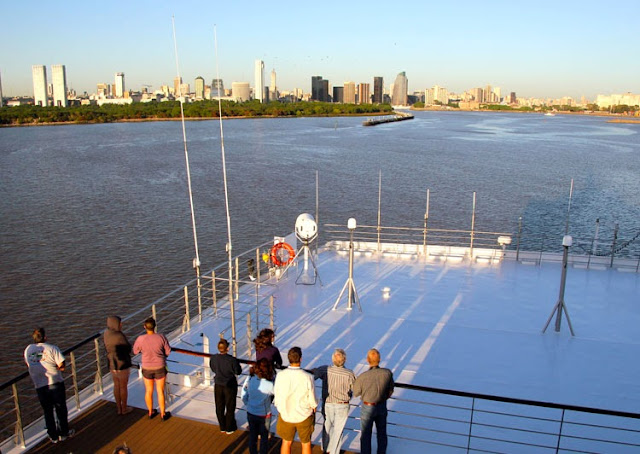 |
| Entering Bueno Aires |
Buenos Aires ‘faces’ Europe, emulates Paris, and feels familiar
to North American city folks. People in Buenos Aires are Italian, German, Spanish, Jewish, Eastern European – just about anything but indigenous populations. With the numerous parks, broad boulevards,
colonial architecture, and the old world cemetery, frequent comments were “this
reminds me of NYC”, “it’s like Washington
DC", "Chicago….” and more.
The climate of Buenos Aires is temperate and, for the days
of our visit, blue-sky perfect and just-the-right warm. At this time of year, coming off winter,
every person is thrilled to be entering Spring….never mind for now the hot
summer coming later. The purple blossomed Jacaranda trees were gloriously
showing their colors in most of the city parks.
The people in Buenos Aires LOVE their dogs; daily dog-walking is a job for many young men and women. Commonplace dogwalkers manage groups of 3 to 15 dogs of similar size along the sidewalks and in the parks. Pooper-scoopers are NOT apparent, so one must keep a vigilant eye downward to avoid a mess.
Along with a group of SASers, we toured the various
districts and a variety of old-time cafes. The coffee is good and the pastries
are rich and sugary. The sweet Dolce de
Leche (carmelized sweetend condensed milk) is ubiquitous – in cakes, on
pastries, in cheesecake, and standing alone as a melt-in-your mouth sweet
candy. Yummy.
Buenos Aires has a rich tradition of cafés and coffee houses where Argentine poets, writers, and playwrights gather and work. The cafes were central in the resistance activities to the atrocities of the authoritative military junta at the time of The Dirty War, 1976-1982, the time of ‘the disappeared,” To this day ‘the Mothers’ protest weekly at noon on Thursdays in the plaza of The Pink House, the central government building of Argentina.
 |
| A sidewalk plaque outside Cafe de los Angelinos to commemorate the sidewalk deaths of several people duringThe Dirty War |
 |
| Cafe de los Angelinos |
 |
| Derego Coffe House |
 |
| Statue of a famous patron outside La Biela |
 |
| La Biela |
 |
| El Ateneo, a former theater, is now a bookstore with a coffee shop in the stage area. |
La Boca

La Boca - a colorful artistic community with sidewalk cafes and art for sale is a popular tourist attraction. The sidewalk art is actually quite high calibre, the trinkets are plentiful, and the atmosphere is delightful.
The Tango
And in Buenos Aires, there is the Tango. Originally
developed in the districts along the Rio de la Plata, the border between
Argentina and Uruguay, this dance was sometimes banned in Europe for being
overly sexual.
This severe and dramatic dance is everywhere – tango dancing
schools, tango dinner shows, tango at cafes, tango on tiny sidewalk stages
beside restaurants. UNESCO has even
declared it an “Intangible Cultural Heritage.”
 |
| Tango dancers at a sidewalk cafe in La Boca |
 |
| Tango Dancers waiting for their public |
Eva Peron
Evita Peron holds a remarkable place in the hearts and minds
of Argentines. Elevated to popular
sainthood, her words and deeds are quoted and her image is everywhere.
The Eva Peron Foundation operates an excellent museum in her
memory, filled with her words, her achievements and her clothing, with numerous
videos and photographs. The wealthy and influential of Argentina, to this day,
decry her as overly ambitious and self-aggrandizing, while the “the people”
continue to adore her. In truth, in her
short life, living only to age 33, Eva Peron’s impact and essence for Argentina
was far more essential and complex than the movie with Madonna described. Before
her death in 1952 she was given the title “Spiritual Leader of Argentina” by
the Congress.
 |
| Louise is not talking on a cell phone, she is contemplating the complexity of Evita. |
Ricoletta Cemetary
In Buenos Aires, the Ricoletta Cemetary is like a high-end district of the city.
Beautifully landscaped and tended, the mausoleums are larger and far grander than homes of the poor and less significant people. Every visitor to the Ricolleta Cemetary parades past Eva Peron’s gravesite at the Duarte mausoleum (12 feet below level, for security) where her body was returned after 20 years in Milan, Italy where it was evacuated at the over-throw of Juan Peron in 1955.























No comments:
Post a Comment